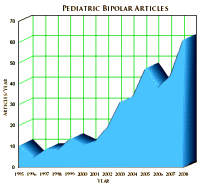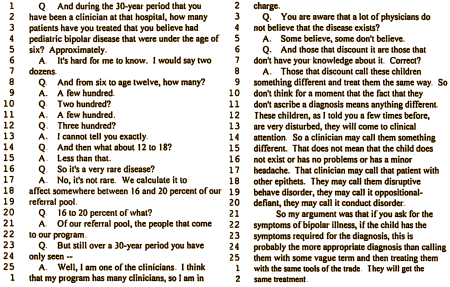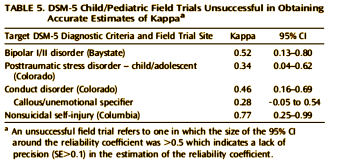DSM-5 Field Trials in the United States and Canada, Part II: Test-Retest Reliability of Selected Categorical Diagnoses and Analytic Approaches
by Darrel A. Regier, William E. Narrow, Diana E. Clarke, Helena C. Kraemer, S. Janet Kuramoto, Emily A. Kuhl, and David J. Kupfer
American Journal of Psychiatry. 2012 October 30, AJP in Advance
[modified to fit]
[modified to fit]
"Disruptive mood dysregulation disorder. This condition was proposed to differentiate patients with pediatric bipolar disorder and those with some similar symptoms who did not progress to adult bipolar disorder. However, the field trial data present a challenging case in which one site, the one with the largest number of patients [predominantly from the inpatient service], produced a good level kappa of 0.49 [95% CI=0.33–0.66], whereas two other sites that obtained patients primarily from outpatient settings produced unacceptable kappas. Since the major distinction between this disorder and oppositional defiant disorder or intermittent explosive disorder is the presence of persistent irritability and anger mood states between frequent rage reactions, it appears that this disorder is more reliably diagnosed in its more severe form and with longitudinal assessment associated with inpatient hospitalization. This is consistent with the “severe mood dysregulation” disorder, which has been differentiated from pediatric bipolar disorder in the NIMH studies that provided the research basis for this proposal."
Finding out that Janssen had tried and failed to get Risperdal approved for disruptive kids through the FDA sometime after 1998 got that all stirred up in my mind again. Here is the timeline that keeps rolling around in my mind…
I now know that Janssen wanted to get Risperdal approved for disruptive kids early on. The FDA turned them down. Dr. Biederman had been approaching Janssen to fund a Center at MGH. After Biederman published a positive study of Zyprexa for bipolar kids, Janssen did fund Biederman’s Center and Biederman began to focus on Risperdal. The broad facts are that:
So I can’t shake the suspicion that the inclusion of so many kids in the bipolar category was simply a way to rationalize treating them with Atypical Antipsychotics. I feel pretty confident that was a Janssen motivator. I suspect Biederman’s group of being a part of that too, but it’s mostly a nagging hunch that just won’t go away. The circumstantial evidence is the timeline, the oddness of the expansion of the diagnostic criteria for childhood bipolar disorder, the slimness of the scientific evidence for that expansion, the inclusion of an old Janssen study of disruptive retarded kids in the ‘bipolar child’ literature, and the jury-rigging of that study’s clinicaltrial.gov information.
 FDA indication in disruptive children. Failing at that when the FDA said no dice, the trial was later revived and launched Dr. Biederman’s Bipolar Child craze with an Excerptia Medica ghost-written article in 2002. But after a period of what I call Biedermania in which the diagnosis of Bipolar Child increased 40 fold and the use of Atypical Antipsychotics in children soared, people began to increasingly question the diagnosis, Senator Grassley included Dr. Biederman on his unreported pharmaceutical income list, and Doctor Biederman found himself on the witness stand being challenged [2009] and began to sing a different tune:
FDA indication in disruptive children. Failing at that when the FDA said no dice, the trial was later revived and launched Dr. Biederman’s Bipolar Child craze with an Excerptia Medica ghost-written article in 2002. But after a period of what I call Biedermania in which the diagnosis of Bipolar Child increased 40 fold and the use of Atypical Antipsychotics in children soared, people began to increasingly question the diagnosis, Senator Grassley included Dr. Biederman on his unreported pharmaceutical income list, and Doctor Biederman found himself on the witness stand being challenged [2009] and began to sing a different tune: 
So in July 2011, Dr. Biederman was censured by Harvard [bipolar kids: harvard acts…], and the diagnosis of the Bipolar Child has begun to smell more and more like three day old fish. But in spite of the odor, the use of Atypical Antipsychotics in children continues to be a problem.
Somewhere along the path from then to now, the DSM-5 Task Force takes on the problem of the overmedication of children and the epidemic of diagnosing out-of-control children as being Bipolar, and comes up with the solution of creating a new group – the Disruptive Mood Dysregulation Disorder [This condition was proposed to differentiate patients with pediatric bipolar disorder and those with some similar symptoms who did not progress to adult bipolar disorder.]. And in spite of an outcry, the diagnosis made it to the Field Trials [see above] where it more or less bombed except at a site where most of the subjects were in-patients. Note: The worry about over-medicating these kids with these drugs is largely an out-patient issue – office practice, foster kids.
-
1993: Risperdal comes on the market approved for Schizophrenia. Jannsen forms the Risperidone Disruptive Behavior Study Group aiming towards extending the approved indications to disruptive behavior in children.
-
1995: Janssen asks Dr. Biederman to submit a grant request to study Risperdal in kids [Bipolar kids?], but when he does, they turn him down. He’s plenty pissed off.
-
1998: Janssen completes the trial in disruptive children and tries for FDA approval, but is turned down. Part of the reason given is that the request was for a behavior [disruptiveness] rather than for a Disorder [a diagnosis].
-
1999 & 2001: Dr. Biederman publishes Clinical Trials for non-Janssen drugs in Bipolar children [Zyprexa and Depakote].
-
2002: Janssen woos Dr. Biederman back into the fold by funding a Center at Harvard. Dr. Biederman then signs on to an Exceprta Medica article [ghost-written] that is a re-write of the 1998 Trial in Disruptive children presented at the AACAP meeting [2002] and later published [2006].
-
~2002 to ~2008: The Biedermania Era. There is a 40 fold increase in the diagnosis of childhood Bipolar Disorder. The journals fill with articles and it’s a hot topic at conferences. There is a frenzy of off-label prescribing [see “sunlight is the best disinfectant”…].
-
2008: Senator Grassley’s investigation of unreported pharmaceutical income includes Dr. Biederman who first denies the charge, the admits to ~$1 M worth of unreported income.
-
2009: 60 Minutes does a program about Bipolar Children focusing on Rebecca Riley, a four year old who died from over-medication.
-
2011: Harvard censures Dr. Biederman and restricts him from doing industry funded studies for two years.
-
Meanwhile, the DSM-5 Task Force begins to consider adding a diagnosis – Disruptive Mood Dysregulation Disorder – specifically planned to decrease the diagnosis of distruptive kids as Bipolar, specifically hoping it would decrease the overmedication of children. It started life as Temper Dysregulation Disorder with Dysphoria but the name got changed along the way.
-
2012: The DSM-5 Field Trials are released with kappas of 0.06, 0.49, and 0.11. Explained away as above.
-
2013: Presumably, will be an official APA Disorder when the DSM-5 is released in May 2013.
So what used to be a behavior is now a Disorder, and we’re supposed to believe that will decrease the prescribing of antipsychotics to kids? Not in a million years. In the modern world of first-line office-practice psychopharmacologic treatment, that diagnosis is sure to be treated just like the Bipolar Child has been treated – with Atypical Antipsychotics. The irony is that the drugs have all just about gone off of patent, so their twenty year old marketing scheme is now about to finally have a solid home in our diagnostic manual in perpetuity. Whether this is intentional misbehavior, unintended consequences, or just plain dumb as hell doesn’t even really matter. The outcome is the same.


When I was putting together a timeline on the path to child drugging in the US I also noticed the “coincidences” you so aptly point out above involving the long history of attempts to get Risperdal prescribed for various disorders that did not even exist. Now it looks like one does exist and yes it sounds eerily similar to the disorder they started out trying to establish in the first place.
Not at all surprised.
BTW: Thanks for all you do and I hope you keep up the good work!
“The fact that the Child Psychiatrists and parents are between a rock and a hard place with these kids is a reality – a difficult reality. But defining a Disorder that will legitimize and routinize over-riding the known toxicity of medications is hardly a solution. It’s already a problem, and this move by the DSM-5 Task Force makes it worse…”
Then, let’s warn parents to – by all means – reject this new ‘diagnosis’ (so-called).
And, Mickey, this is an important post you’ve written. What I feel needs more emphasis is the fact, that: teaching certain kids self-control may require professional help, but it is not rocket science. I.e., there are pros who are good at it; unfortunately, most Child Psychiatrists (I see you are fond of capitalizing that title) are prescribers, firstly; and, so, their attempts at ‘medicating symptoms’ away are short-term, palliative ‘solutions’ for ‘ill’ behavior, at best – which will create, in the long run, iatrogenic disease.
May I suggest the following Youtube:
http://www.youtube.com/watch?feature=player_embedded&v=Td7X3yk2UTg
12 year old Testifies in U S Senate Hearing
(Note: At minute 12:30, one piece of advice from 12-year-old Ke’onte Cook… “That meds aren’t gonna help a child with their problems. It’s just gonna sedate them, make them tired, make them forget it for a while, and then it comes back, it happens again. What I learned in therapy is that, when you’re taking therapy, you talk about the deepest thing, it hurts, then it comes back, but you can handle it better.”)
______________
P.S. — Evelyn, you’ve done great work reporting on these issues.
The few lines I offer below are excerpted from your 2007 article, “World Experts Demand End to Child Drugging in the US–Part 1” (apropos of Mickey’s post):
…neurologist Dr Fred Baughman, a recognized authority on psychotropic drugs and author of “The ADHD Fraud,” stated: “Psychiatry and the pharmaceutical industry married and launched the joint market strategy of calling all emotional and behavioral problems ‘brain diseases’, due to ‘chemical imbalances’, needing ‘chemical balancers’ – pills.”
“Every time parents are [led] to believe that their child’s emotional or behavioral problems are a ‘disease’ due to an abnormality in the brain,” Dr Baughman says, “they are lied to.”